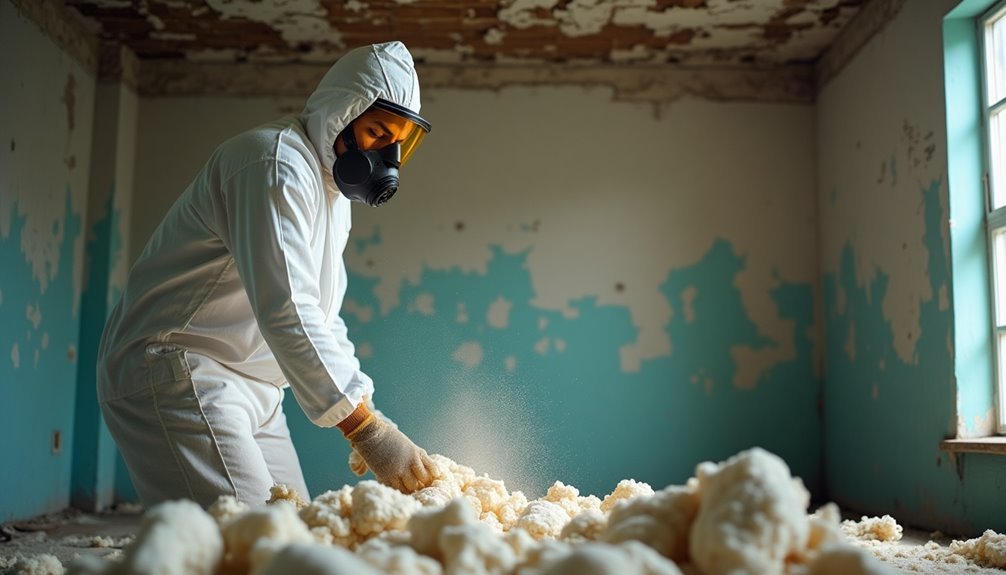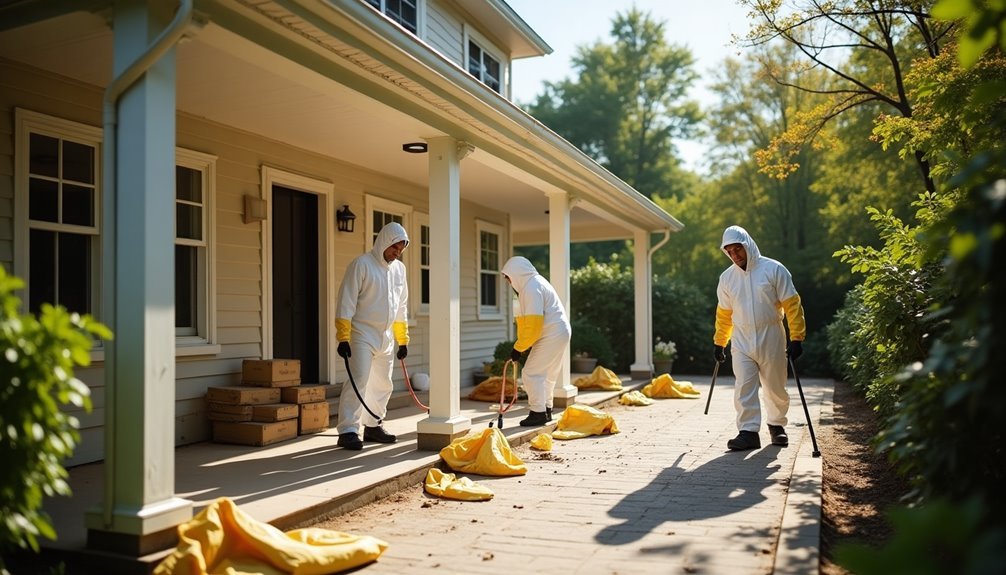Asbestos abatement is crucial for protecting your health and finances. It eliminates exposure to toxic fibers linked to severe diseases, including lung cancer and asbestosis, which can manifest decades later. By hiring trained professionals, you ensure compliance with regulations, avoiding hefty fines. Though removal costs range between $1,192 and $3,255, investing in abatement can enhance property value and reduce long-term expenses, such as lower insurance premiums and legal liabilities. With cost-effective strategies, you can further minimize expenses. Discovering comprehensive abatement methods can provide deeper insights into preserving your health and finances effectively.
Health Risks of Asbestos

Asbestos exposure poses significant health risks, particularly in terms of lung diseases and cancers. You need to recognize that the symptoms of asbestos-related conditions often don't appear until 15-50 years after exposure, making early detection challenging. Asbestos fibers can infiltrate your lungs, leading to serious health issues like lung cancer, asbestosis, and mesothelioma. These fibers remain airborne for extended periods, allowing them to be inhaled or ingested from various exposure sources, such as demolition sites, construction work, and contaminated drinking water.
Additionally, asbestos may cause nonmalignant lung disorders, including pleural plaques and thickening. While there's ongoing research into its link to cancers of the digestive system, evidence remains unclear. You should also be aware that cigarette smoking significantly heightens the risk of lung cancer in those exposed to asbestos, compounding the dangers. Long-term exposure can lead to impaired lung and heart function, resulting in disability or death.
Long-term exposure, whether in an occupational setting or from environmental contamination, can yield dire consequences. It's crucial to understand these risks to make informed decisions about your health and the environments you inhabit. By addressing asbestos exposure proactively, you can take steps toward a healthier, liberated future.
Benefits of Professional Abatement
When you consider professional asbestos abatement, you're investing in both health protection and financial benefits. Trained contractors use specialized techniques to minimize exposure risks, ensuring a safer environment for everyone involved. Additionally, effective planning and competitive pricing can lead to significant cost savings, making it a smart choice for managing asbestos issues. The importance of accurate asbestos testing cannot be overstated, as it identifies potential hazards before they escalate into serious health risks.
Health Protection Measures
Ensuring a safe living or working environment hinges on the effective removal of hazardous materials like asbestos. By opting for professional asbestos abatement, you significantly reduce the risk of asbestos exposure, effectively protecting your health and that of others around you. This process not only prevents inhalation of harmful asbestos fibers but also ensures a healthier environment free from the dangers associated with these materials.
| Health Protection Measures | Benefits |
|---|---|
| Removal of Asbestos Sources | Protects occupants from long-term health risks |
| Protective Gear for Technicians | Prevents exposure during abatement |
| Containment Strategies | Eliminates risk of fiber contamination |
| Compliance with Regulations | Ensures safe and legal disposal of materials |
| Use of HEPA Filtration | Captures dangerous fibers during cleanup |
Financial Investment Benefits
Investing in professional asbestos abatement not only safeguards your health but also offers significant financial advantages. By ensuring compliance with asbestos regulations, you avoid hefty fines that can reach up to $250,000 per violation, along with daily penalties of $37,500. This proactive approach mitigates the risk of incurring costs associated with legal liabilities and environmental remediation.
Moreover, removing asbestos can enhance your property's value. Potential buyers are increasingly attracted to safe, healthy living spaces, making your property more marketable. This heightened appeal translates into better investment returns when you decide to sell or rent.
Cost-effective strategies, such as encapsulation and prioritizing high-risk areas, can reduce expenses by 15-25% without sacrificing safety. Additionally, exploring financing options like grants and loans can help offset initial costs, making the investment more manageable.
Ultimately, professional abatement isn't just about immediate safety; it's a long-term financial strategy. By preventing future costs linked to asbestos-related illnesses and ongoing compliance issues, you protect yourself from the significant economic impact of potential lawsuits and health crises. Investing in abatement is an investment in your financial future.
Financial Advantages of Abatement

As you consider asbestos abatement, it's crucial to recognize the financial advantages it offers. By removing asbestos, you can enhance your property's value significantly, attracting higher offers and quicker sales. Additionally, you can save on costs through various financial assistance options and reduced insurance premiums, making abatement a smart investment.
Cost Savings Overview
When you choose to remove asbestos from your property, you're not just safeguarding health; you're also unlocking significant financial advantages. A thorough cost analysis reveals that, with effective budget planning, you can experience substantial savings. Here are four key areas where you'll find financial relief:
- Reduced Maintenance Costs: Without asbestos, you eliminate ongoing, specialized maintenance and costly repairs, allowing your budget to stretch further.
- Lower Insurance Premiums: Removing asbestos often leads to reduced insurance rates, as providers view your property as a lower risk.
- Financial Assistance Opportunities: Many grants, loans, and tax benefits exist to ease the financial burden of abatement, making it more affordable.
- Avoidance of Fines: Complying with asbestos regulations protects you from hefty fines and legal liabilities, safeguarding your finances.
Property Value Enhancement
Removing asbestos not only protects your health but also significantly enhances your property's value. Properties that have undergone asbestos abatement are increasingly attractive in today's competitive market. Buyers are well-informed and often prioritize safety; thus, the absence of asbestos elevates your property's market perception and appeal. As market trends shift towards health-conscious living environments, homes free from hazardous materials like asbestos naturally command higher prices.
Moreover, properties with documented asbestos removal can preserve or even enhance their resale value. This proactive measure prevents potential buyers from leveraging asbestos issues to negotiate lower prices, ensuring you retain maximum value. In addition, minimizing liability risks associated with asbestos contamination makes your property more appealing to investors and buyers alike. Compliance with federal, state, and local regulations not only boosts marketability but also reduces the threat of fines and legal complications.
In essence, by investing in asbestos abatement, you're not just safeguarding your well-being; you're also making a strategic choice that can yield substantial financial benefits in the future. Embracing this process allows you to navigate market trends while enhancing your property's overall worth.
Understanding Abatement Costs
Understanding the costs associated with asbestos abatement is crucial for homeowners and property managers alike. The financial implications can be significant, so grasping the various factors influencing cost estimation is key. Here are four major considerations that can evoke a deeper understanding of the potential expenses:
- Size of the Affected Area: Larger areas naturally incur higher costs.
- Location of Asbestos: Harder-to-reach areas demand more specialized removal techniques, raising costs.
- Type of Asbestos: Dangerous varieties like amosite require more stringent removal processes, increasing expenses.
- Geographical Location: Urban settings often face higher service fees and disposal costs compared to rural areas.
On average, asbestos removal costs around $2,215, with a range from $1,192 to $3,255. Indoor remediation can run $5 to $20 per square foot, while exterior removal can soar to $150 per square foot. Remember, testing, permits, and specialized equipment also add to your overall expenses. By understanding these costs, you empower yourself to make informed decisions and prioritize your health and property safety.
Strategies to Reduce Costs

Asbestos abatement can be a significant financial burden, but there are effective strategies to mitigate costs. By employing sound cost management techniques and thorough project planning, you can save money while ensuring safety.
| Strategy | Benefits |
|---|---|
| O&M Program | Maintains asbestos in place; least-cost option if undisturbed. |
| Combine Work Scopes | Saves time and resources; reduces overall costs significantly. |
| Optimal Contractor Hiring | Streamlines processes; minimizes regulatory compliance risks. |
| Risk-Based Assessment | Ensures appropriate abatement methods, reducing unnecessary expenditures. |
Deferring abatement until renovation or demolition can also help you avoid additional costs like lost productivity and rental expenses. Evaluating costs over 50 years with a 4.5% discount rate allows for more informed decision-making.
Regulatory Compliance Essentials
How can you navigate the complex landscape of regulatory compliance in asbestos abatement? Understanding the various regulatory frameworks is crucial to overcoming compliance challenges that can arise during your project. Here are four essential steps you should take:
- Notify the EPA: Always submit the required notification form before disturbing asbestos-containing materials.
- Follow NESHAP Regulations: Familiarize yourself with the National Emission Standards for Hazardous Air Pollutants to ensure safe work practices.
- Check State and Local Standards: Remember, local regulations might be stricter than federal requirements, so verify those.
- Hire Certified Inspectors: Engage certified asbestos inspectors to conduct thorough surveys and risk assessments.
Long-Term Safety Measures

After ensuring compliance with regulatory standards, the focus shifts to implementing long-term safety measures for managing asbestos-related risks. Start by conducting thorough inspections to identify asbestos-containing materials, followed by laboratory analysis to confirm their presence. A detailed abatement plan should outline the scope, timelines, and safety protocols, ensuring you notify regulatory agencies and obtain necessary permits before beginning work.
During the abatement process, utilize containment techniques such as encapsulation for intact materials and employ removal methods for damaged ones. Use wet cleanup tools and HEPA filter vacuums to minimize fiber release, and place asbestos materials in labeled, leak-tight containers. Negative air machines are crucial for filtering the air throughout the process.
Post-abatement, conduct clearance testing and air monitoring to verify the area is safe for re-entry. Regularly inspect your property for signs of wear on asbestos-containing materials, avoiding any disturbance to intact materials. Implement a maintenance plan and engage in long-term monitoring to manage remaining asbestos safely. By adhering to these measures, you can significantly reduce health risks and ensure a safer environment for yourself and others.
Case Studies and Success Stories
Highlighting successful asbestos abatement projects reveals effective strategies and outcomes that can serve as valuable models for future efforts. These case studies emphasize the importance of asbestos awareness and demonstrate how proper removal techniques can lead to significant benefits. Here are four key takeaways from notable projects:
- Comprehensive planning and community consultation enhance safety and effectiveness.
- Specialized equipment ensures efficient removal while maintaining operational integrity.
- Phased removal minimizes disruption and fosters ongoing safety.
- Successful abatement boosts property value and compliance, offering long-term financial savings.
The Former Balfours Building in Adelaide exemplifies meticulous planning and execution, with over 1,500 tonnes safely removed. The Vanderbilt University Medical Center completed a $2 million project under budget, showcasing efficiency while prioritizing safety. Similarly, Dallas Brooks Hall's $9 million venture involved extensive community engagement, further demonstrating successful asbestos removal.
Through these case studies, it's clear that embracing robust removal techniques not only protects health but also liberates properties from the shackles of asbestos. These success stories inspire a proactive approach to asbestos management, fostering a safer and more valuable environment for all.
Conclusion
In the end, you might think ignoring asbestos is cheaper, but the irony lies in the hidden costs of long-term health risks. By investing in professional abatement, you're not just protecting your home; you're safeguarding your future. While the upfront expense might seem daunting, it pales in comparison to potential medical bills and lost quality of life. Prioritizing safety today ensures peace of mind tomorrow, proving that sometimes, the true savings come from facing what we fear most.
